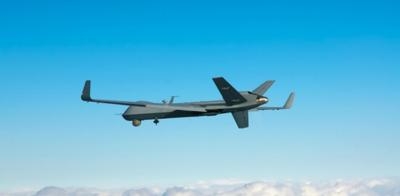Mon, Mar 07, 2016
Upgrade Dramatically Increases Flight Time; Advances Next-Gen Predator
General Atomics Aeronautical Systems has conducted the first flight of a Predator B/MQ-9 Reaper Extended Range (ER) Long Wing, retrofitted with improved long-endurance wings with greater internal fuel capacity and additional hard points for carrying external stores. The flight occurred on February 18 at GA-ASI’s Gray Butte Flight Test Facility in Palmdale, Calif., on a test aircraft.

“Predator B ER’s new 79-foot wing span not only boosts the RPA’s endurance and range, but also serves as proof-of-concept for the next-generation Predator B aircraft that will be designed for Type-Certification and airspace integration,” said Linden Blue, CEO. “The wing was designed to conform to STANAG 4671 (NATO Airworthiness Standard for RPA systems), and includes lightning and bird strike protection, non-destructive testing, and advanced composite and adhesive materials for extreme environments.”
During the flight, Predator B ER Long Wing demonstrated its ability to launch, climb to 7,500 feet (initial flight test altitude), complete basic airworthiness maneuvers, and land without incident. A subsequent test program will be conducted to verify full operational capability.
Developed on Internal Research and Development (IRAD) funds, the new wing span is 13-feet longer, increasing the aircraft’s endurance from 27 hours to over 40 hours. Additional improvements include short-field takeoff and landing performance and spoilers on the wings which enable precision automatic landings. The wings also have provisions for leading-edge de-ice and integrated low- and high-band RF antennas. An earlier version of Predator B ER featuring two wing-mounted fuel tanks is currently operational with the U.S. Air Force as MQ-9 Reaper ER.
The long wings are the first components to be produced as part of GA-ASI’s Certifiable Predator B (CPB) development project, which will lead to a certifiable production aircraft in early 2018. Further hardware and software upgrades planned for CPB will include improved structural fatigue and damage tolerance, more robust flight control software, and enhancements allowing operations in adverse weather.
(Image provided with General Atomics news release)
More News
Aero Linx: Vintage Sailplane Association The purpose of the Vintage Sailplane Association (VSA) is to promote the acquisition, restoration and flying of vintage sailplanes by its m>[...]
Smoke Began Entering The Cockpit During The Landing Flare, And Then The Pilot Noticed Flames... Analysis: The pilot reported that about 30 minutes into the local flight, he heard s>[...]
Make Sure You NEVER Miss A New Story From Aero-News Network Do you ever feel like you never see posts from a certain person or page on Facebook or Instagram? Here’s how you c>[...]
From 2010 (YouTube Edition): The Red Tail Project Continues Effort Towards ‘Rise Above Program’ The Red Tail Project is a true example of this unbreakable spirit. In 20>[...]
Also: 1st-Ever Space Crime Was a Fraud, IAE Buys Diamonds, Kennon Bows Out, Perseverance Rover An interesting moment came about this past Sunday as ANN CEO, Jim Campbell, noted tha>[...]
 ANN's Daily Aero-Linx (11.25.25)
ANN's Daily Aero-Linx (11.25.25) NTSB Final Report: Glasair GlaStar
NTSB Final Report: Glasair GlaStar ANN FAQ: Turn On Post Notifications
ANN FAQ: Turn On Post Notifications Classic Aero-TV: Red Tail Project Update Taking the Mission to the People
Classic Aero-TV: Red Tail Project Update Taking the Mission to the People Airborne 11.24.25: ANN's 30th!, Starships V3 Booster Boom, Earhart Records
Airborne 11.24.25: ANN's 30th!, Starships V3 Booster Boom, Earhart Records



